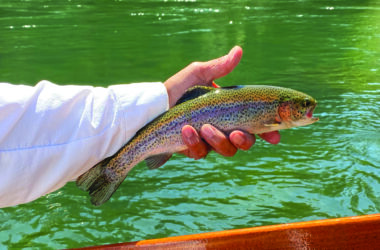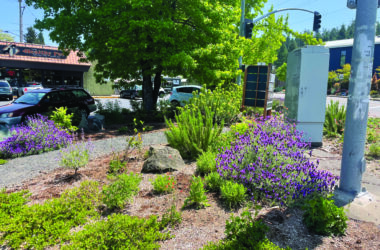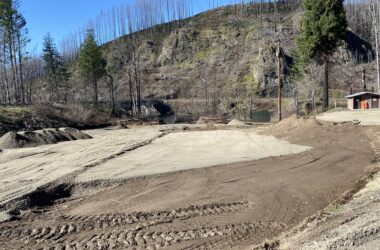 FRANK ARMENDARIZ – THE ANGLER’S LOG
FRANK ARMENDARIZ – THE ANGLER’S LOG
Let me begin by telling you all that spring chinook salmon will soon be in our local rivers. But we might have to wait just a little longer than usual for them to reach us this year. Let me explain.
It was in late March and our improving spring weather had warmed the water of the Willamette River about 10 degrees from a low of 46 degrees back in mid-March. At the Willamette Falls in Oregon City, the water temperature had reached the mid-50-degree range and within a couple of days of breaking that temperature threshold, spring chinook salmon began to climb the Willamette Falls fish ladder, swimming past the fish passage observation window, where a camera records their movement through the ladder 24/7. It was a trickle at first, three or four fish a day were observed through the window and recorded on the camera.
Then in the first week of April, the numbers of salmon counted gradually increased and on two consecutive days the number of salmon passing the observation window grew from a handful to several dozen. Given that the conditions were perfect and the fish willing, it looked like the spring salmon run into the valley had turned on.
Then, like it often does, the weather changed to something more reminiscent of a late January or early February chill. Record cold for April descended on the Willamette Valley and much of the state. Bringing a cold rain, hail and snow fell on a few valley communities along with something the weather service calls “graupel.”
A concoction of snow and ice that covered other portions of the Willamette Valley too. The cold snap was a shock to the system and water temperatures at the Willamette Falls fell back into the mid-40s, the cold water bringing a building spring salmon migration to a complete standstill, literally overnight.
Now before we get all gloomy, this is not necessarily bad news for salmon anglers. I can report that fishing below the Willamette Falls this year has been “good” and the run size is promising. It will likely be a couple of weeks but once the water temperatures warm back to the mid-50s, I expected the upriver salmon migration to be robust. The cold snap delaying the run will extend the peak into early summer, warmer weather and warmer water temperatures. And the likelihood that the milder conditions will stimulate a better bite. Once past the falls, salmon take about 10 to 14 days to reach the tributaries in the southern Willamette Valley. You can monitor the numbers heading our way at this website:
dfw.state.or.us/fish/fish_counts. From there, click on willamette, 2022/2022, monthly sheet. It’s a PDF document.
***
The Willamette Valley’s run of hatchery summer steelhead is also on the way. Less affected by cold water, several hundred have already made their way through the falls’ fish passage and should begin reaching the Middle Fork of the Willamette and the McKenzie River in the next couple of weeks. A disappointment to both anglers and fish biologists has been the low numbers of summer steelhead that have actually made their way back to the upper tributaries hatcheries in recent years. Also remember that in the 2020 as a fire storm was bearing down on the Leaburg Hatchery and had cut the power off to the holding pounds, hatchery staff made the decision to release thousands of fish in the process, including all the hatchery steelhead, six months earlier than normal. Unfortunately all the steelhead went out as fingerlings. Their survival at that size, according to the ODFW, is expected to be “very low.” This season’s summer steelhead run also looks promising, a good summer run this year would be a bit of a conciliation and a welcome reversal of recent years. I have my fingers crossed.
***
In other salmon news, just last week the ODFW finalized the sport ocean salmon fishing season and established this season’s sport fishing allocation. That technically opened on March 15 but has been on hold until now. Like in recent seasons, fishing is limited to two barbless hooks per line and a single rod per person. Except for waters north of Cape Falcon where the minimum chinook length is 22”, in all other ocean zones the minimum is 24” for chinook and 16” for coho. On the far north coast zone, from Leadbetter Point in Washington to Cape Falcon in Oregon the season begins on June 25 through Sept. 30 with a quota of 84,000 fin clipped coho and 7,700 chinook. The angler limit is two salmon per day, only one of which can be a chinook.
From Cape Falcon south the Humbug Mountain, that season is now open and runs until Oct. 31. The limit is two salmon per day and is currently closed to the retention of coho. Non-selective coho season that extends from Cape Falcon to the Cal border is set to open on June 18 through Aug. 21 or until a quota of 100,000 hatchery coho are caught. Non-selective coho season opens Sept. 3 through Sept. 30, 2022 or until a quota of 17,000 wild coho are caught. With a limit of two salmon per angler per day of chinook or coho. Humbug Mountain to the California border opens for hatchery coho on June 18, then on June 25 for chinook and both seasons run through Aug. 21. Here the limit is two salmon per day and only hatchery coho may be retained.
The bay and estuary season is yet to be determined, last season included several non-selective coho retention opportunities. As I review the current coho allocation I expect a repeat of last season’s coho bounty and that a wild coho retention season will return this fall. Stay tuned.
***
After a two-year hiatus (because of the pandemic) the Historic Wood Boat Festival returns to Eagle Rock Lodge on the McKenzie River in Nimrod. Eagle Rock was one the of the only riverside lodges in the recovery zone that escaped the 2020 fire undamaged and for the most part much of the surrounding grounds remain intact too. The show is a production of the McKenzie River Guides Association, established in 1931, and are the oldest associations of river guides in the world.
I should disclose that I am proudly a longtime member of the Guides Association and that my introduction to the McKenzie River drift boat 42 years ago was a life-changing event that set me on a different life path.
I will add that festival is as much a celebration of the rich history and culture of river guiding, a tradition that began on the McKenzie River nearly 120 years ago. As much as it is in honor of the river boat at the foundation of the river-guiding industry.
A boat that was invented and refined on the banks of the McKenzie River to fish the pools and run the river’s many rapids. In modern times, the McKenzie River drift boat can now be found floating on rivers all over the world.
This year the festival is Saturday, April 23, at Eagle Rock Lodge, 49198 McKenzie River Highway, Vida. The lodge is located between milepost 34 and 35.
Come, relax by the river and learn about the river and the history of this influential double-ended boat. The show runs from 10 a.m.-4 p.m. Admission is free but for a small fee, food and beverages are available.
Email: [email protected]
Radio: KDUN (1030 AM)








